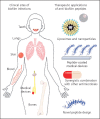Design and Assessment of Anti-Biofilm Peptides: Steps Toward Clinical Application
- PMID: 30134244
- PMCID: PMC6738209
- DOI: 10.1159/000491497
Design and Assessment of Anti-Biofilm Peptides: Steps Toward Clinical Application
Abstract
Highly antibiotic resistant, microbial communities, referred to as biofilms, cause various life-threatening infections in humans. At least two-thirds of all clinical infections are biofilm associated, and antibiotic therapy regularly fails to cure patients. Anti-biofilm peptides represent a promising approach to treat these infections by targeting biofilm-specific characteristics such as highly conserved regulatory mechanisms. They are being considered for clinical application and we discuss here key factors in discovery, design, and application, particularly the implementation of host-mimicking conditions, that are required to enable the successful advancement of potent anti-biofilm peptides from the bench to the clinic.
Keywords: Anti-biofilm peptides; Biofilm infections; Physiologically relevant conditions.
© 2018 The Author(s) Published by S. Karger AG, Basel.
Figures
References
-
- Römling U, Balsalobre C. Biofilm infections, their resilience to therapy and innovative treatment strategies. J Intern Med. 2012;272:541–561. - PubMed
-
- Wolfmeier H, Pletzer D, Mansour SC, Hancock REW. New perspectives in biofilm eradication. ACS Infect Dis. 2018;4:93–106. - PubMed
-
- Hall-Stoodley L, Stoodley P. Evolving concepts in biofilm infections. Cell Microbiol. 2009;11:1034–1043. - PubMed
Publication types
MeSH terms
Substances
Grants and funding
LinkOut - more resources
Full Text Sources
Other Literature Sources


